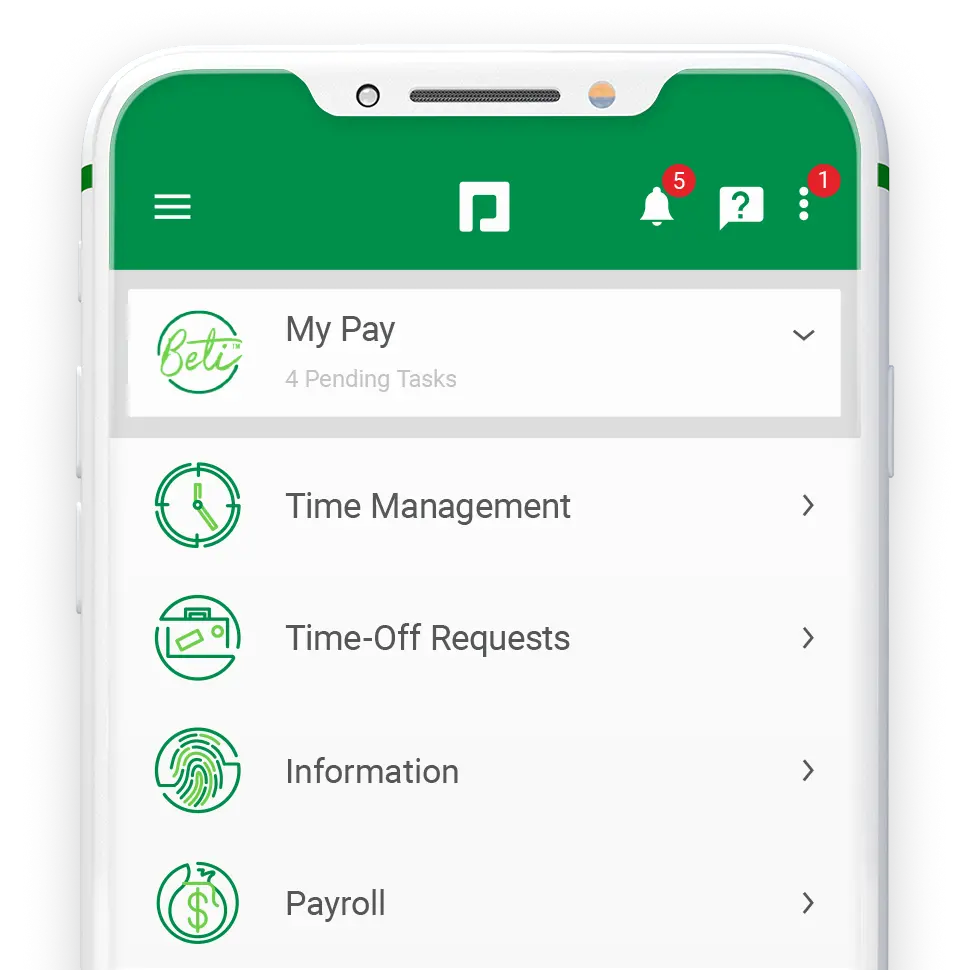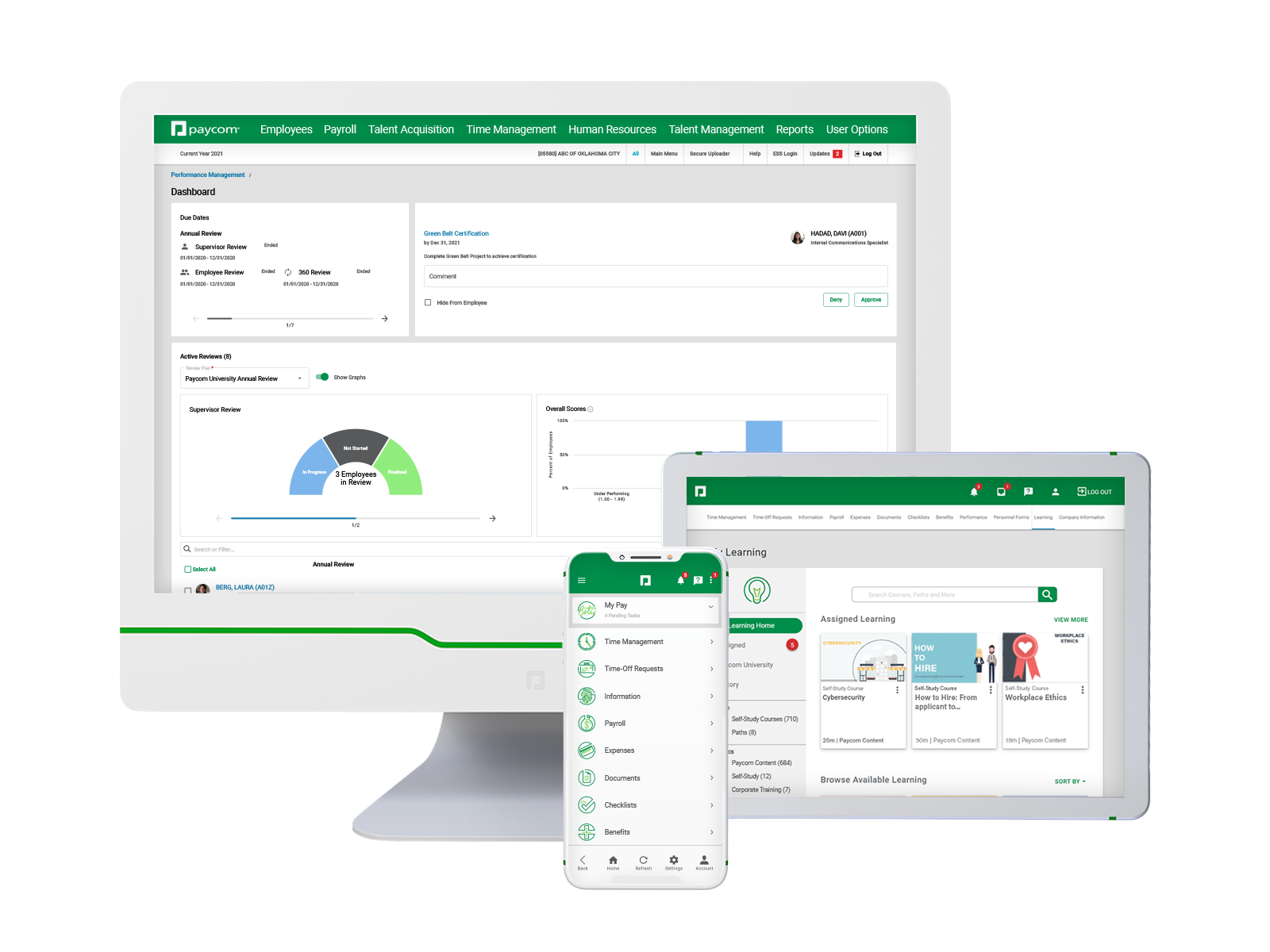Talent Management software
Comprehensive tools to engage and develop your workforce
HOW YOU BENEFIT
An employee-management solution in a single software
Paycom’s Talent Management tools help you build and manage your No. 1 asset — your people — so you can retain top performers for an even sharper competitive edge. These tools help you create career paths, keep employees on track and help them grow. That’s the power of one.

Tools like Employee Self-Service® and Paycom Learning help your workforce take control of their data and complete training courses at their convenience, 24/7, through our easy-to-use app.

With our Performance Management and Compensation Budgeting tools, you’re able to consistently evaluate employees and reward them fairly, within budget and without hassles.

Our labor management software allows you to manage personnel, staffing needs and organizational structure with greater consistency, efficiency and effectiveness.
Talent Management at a glance
Performance Management
Complete employee assessments with consistency, efficiency and less burden.
Compensation Budgeting
Reward employees easily and fairly while staying within budget.
Position Management
Efficiently manage your workforce, staffing needs and organizational structure.
Employee Self-Service®
Empower employees to enter and update their HR data on an easy-to-use app.
Paycom Learning
Easily and consistently train your employees as you engage them with ongoing development.
Explore more tools in our single software
Explore more tools in our single software
Develop, Engage and Retain Top Talent
Over 6.5 million Americans rely on Paycom’s technology every year
Talent management solution for every industry
Paycom’s comprehensive talent management tools help engage and develop employees in small, medium, large and enterprise businesses in all industries. Whether you work in health care, finance or technology, our tools can help your unique workforce grow.


A talent management software company you can trust
Paycom provides the talent management tools you need. Employees are empowered to own their own data in Employee Self-Service®, and why not? They know it best. You’re able to keep your employees engaged while giving them opportunities to develop. And our automated, streamlined process allows you to evaluate and compensate your people fairly, consistently, efficiently and accurately. With Paycom, you can manage your workforce worldwide — all in our secure single software.
Explore these resources for greater talent management insight
FREQUENTLY ASKED QUESTIONS
Get to the heart of what our Talent Management tools do for businesses
Paycom simplifies your talent management efforts by giving you a single software through which you can manage the process from hiring to retirement. Implementing a comprehensive talent management strategy is easy with a single software that streamlines performance reviews, automates compensation budgeting, manages position pay rates and delivers engaging learning content.
When you can view the status of these talent management tools and their related analytics through our single software, staying on top of the development and engagement of your workforce is easy.
Talent management requires the participation of multiple departments, and Paycom’s single software helps streamline interdepartmental communication for a more cohesive operation that benefits everyone involved.
Talent management is more than just hiring for open positions. It’s about bringing out the best in employees and enabling them to flourish. This begins by identifying the skills that a position requires and those employees possess, then making sure learning and advancement paths — both continuous and defined — are clear.
Like the name suggests, HR talent management software (sometimes referred to as “employee management software”) covers a variety of HR processes that span across the entire employee life cycle. This can include learning and development, performance management, employee engagement and retention.
From the front-line employees up to the CEO, a successful talent management program requires everyone’s participation for it to succeed.
At the very top, leadership needs to make a commitment to invest in talent development. The HR team also plays a critical role, as they reinforce the commitments set by leadership and oversee the key components of a talent management strategy.
Managers may have the greatest involvement, as they’re tasked with assessing performance, providing feedback and even the hiring and firing decisions that determine who will be available to participate in this initiative.
When employees are given a first-class experience with self-service tools that allow them to manage their performance reviews, learning and development, they help drive the talent management strategy and prove its effectiveness.
People are the heart of any organization. When they improve their work, they help the organization succeed and they’re less likely to become dissatisfied and begin looking elsewhere for career opportunities.
When implemented effectively, talent management initiatives can be the catalyst for a next-level employee experience. Intuitive, self-service systems give employees the tech they want at work, and that same tech can be used to connect them with the development resources they need to grow their careers.
Without a talent management strategy, you risk high turnover, poor engagement and low productivity. Not to mention the extra cost of recruiting, onboarding and training all the new employees who cycle through your organization.
Employees want to be good at their jobs. When they are challenged in their work and presented with opportunities for growth, it builds satisfaction and engagement with their work. In short, employees who get their professional needs met at work are less likely to leave for an outside position.
A comprehensive talent management strategy increases employee retention by encouraging these elements of a beneficial employee experience throughout the employee life cycle.
A talent management system is integrated software housing processes and components of personnel management, including:
- employee and workforce planning
- talent retention
- talent tracking
- performance management
- career mapping and development
- compensation strategy and communication
A talent management system may be part of a human capital management system (HCMS), but it does not include administrative elements such as onboarding, employee self-service, time tracking, payroll or benefits administration.
A talent management system holds all aspects of teams’ performance, skills, goals, trajectory and more to aid leaders in assessing their strengths and ability to accomplish key business objectives. Talent management systems may be the single source of truth regarding an employee’s work, including their past performance, future potential and ideal professional trajectory. Leaders, managers and individual contributors can rely on these platforms to plan for the future.
The process of talent management can take many forms. One of the most popular strategies begins with a gap analysis. The steps for a gap analysis are:
- Identifying the organization’s ideal future state. What are its goals? What talent will the team need to achieve them? What skills are needed, and how many people with each specific skill will be needed on each team to perform the necessary tasks and activities associated with success?
- Taking stock of the current team. What skills do team members have? How many have those skills? How likely are those people to stay with the team? What is the retention rate?
- Looking at the ideal future state and comparing it to the current state. What is needed to get from the present state to the ideal future?
Talent management systems can aid in these processes by tracking employee strengths and planning for the future.
The world of human resources brims with best practices for managing talent. A few talent management tips include:
- Focus on the employee experience. Enable employees to make the best use of their time by making processes simple and user-friendly. Make resources readily available, while maintaining an open door. Combine the best of automation and personalization to keep your people the focus of human resources.
- Promote and protect your employer brand. Employers need to continuously manage candidate expectations by ensuring that job ads accurately reflect the reality of each open position. Effectively managing your employer brand also means regularly responding to candidate and employee reviews on career sites like Glassdoor. Sharing company and individual employee success stories with the public and emphasizing the benefits of working with your organization are a few ways to differentiate your organization as an employer of choice.
- Create clear career paths. Showing employees that they have a path of growth and a future with your organization gives them clear expectations and allows them to see themselves in a long-term context. Paycom lets you establish explicit job-level qualifications and expected outcomes. Publish pay grades to show the benefit of growing with the company. Use skills inventories and performance scores to identify those employees best suited for promotion to specific roles.
Talent management involves proactively identifying risks and opportunities as they relate to people operations. Talent management software facilitates the tracking and reporting of data related to compliance, health and safety, such as job-specific safety and sexual harassment prevention training. Typical risks identified and addressed using talent management software include:
Compliance
- Reporting on incomplete required training
- Identifying wage and hour noncompliance like missed mandatory meal breaks
- Conducting pay equity and EEO analysis
Strategic
- Forecasting future workforce needs
Operational
- HR process improvement
- Labor allocation and scheduling
Reputational
- Publishing important contact information, policies and procedures for reporting fraud or harassment
- Effectively advertising the benefits of working at the company in job postings
For all your talent management needs in a single software, request a meeting.






